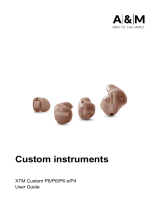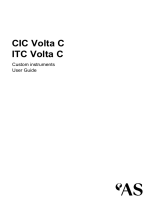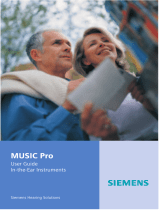Page is loading ...

USER GUIDE
ReSound Match BTE
MA1T70-V,
MA2T70-V, MA2T80-V
MA3T70-V, MA3T80-V

2
3
RESOUND Match
BEHIND-THE-EAR
PERSONAL HEARING SYSTEM
Congratulations on the purchase of your new ReSound hear ing
instrument!
This booklet describes the features available for the BTE (Behind-
The-Ear) models in the ReSound Match product line. The avail-
able options depend on the hearing instrument model; your
hearing care professional will highlight the features of your
particular hearing instrument.
ReSound’s advanced technology and customized programmes,
selected by your hearing care professional, will offer you the
best possible hearing solution to maximize listening situations
in your family life, your professional life and your social life.
Your hearing instrument has been adjusted for your individual
hearing loss. Please familiarize yourself with the information
in this booklet. Proper understanding and use of your new
ReSound hearing instrument will allow you to derive maximum
hearing benet.
This instruction covers the following ReSound Match BTE pro-
ducts: MA1T70-V, MA2T70-V, MA2T80-V, MA3T70-V and MA3T80-V
ReSound Match is a trademark of ReSound A/S.
This booklet & your instrument
In this booklet you will nd instructions for inserting, using and
caring for your new hearing instrument.
Contents page
Your ReSound Match Hearing Instrument ......................4
On/Off Function ..................................................5
Low Battery Warning ............................................6
Changing the Battery ............................................7
Battery Warning Information....................................8
Inserting the Instrument.........................................9
Removing the Instrument...................................... 10
Recognizing Left & Right instrument.......................... 11
Volume Control.................................................12
Pre-Set controls – trimmers.................................... 13
Programme Selector ...........................................14
Telephone use .................................................. 15
T-programme ................................................... 16
Hearing through Induction loop............................... 17
Daily Maintenance .............................................18
Cleaning the Ear Mould ........................................ 19
Repairs.......................................................... 20
General Precautions ........................................... 21
Troubleshooting Guide......................................22-23
Technical Data..................................................24
Key Word Index................................................. 25

4
5
Your ReSound Match MA1T70-V, MA2T70-V, MA2T80-V, MA3T70-V
and MA3T80-V Hearing Instruments
Turning on and off
Your ReSound Match BTE is equipped
with an on/off switch integrated into
the battery compartment.
Turn your hearing instrument on
by closing the battery door.
Turn your instrument off by opening up
the battery door.
When rst turned on, your hearing
instrument will always start
in programme 1.
To read more on this subject,
turn to page 14.
.
• Turning your instrument off when you are not using it will in-
crease the battery life.
• At night, turn off your instrument and open the battery door
completely. It will allow moisture in your instrument to eva-
porate and will increase the instrument’s life span.
Plastic
tube
Ear
mould
Tone tube
Microphone
Volume wheel
Programme
button
Battery door
off
Trimmer(s)

6
7
Low Battery Warning
The hearing instrument has a soft low-battery-warning signal
(beep-beep) that you will hear when the battery voltage/power
gets too low. The signal indicates you should replace the bat-
tery. We recommend that you always carry a spare battery with
you. The low-battery-warning signal will be repeated every 5-10
minutes until the battery runs out of power. The instrument will
then automatically switch off.
Changing the Battery
Open the battery compartment completely, using your nger-
nail to pull back on the small ridge located at the top of the
door. After removing the old battery, insert the new one with
the“+” (at) side facing the “+” on the battery door. Make sure
the battery has been placed correctly into the slot. The battery
door should close very easily. Never use force to close the door
as this may damage your hearing instrument.
MA1T70-V, MA2T70-V, MA2T80-V, MA3T70-V and MA3T80-V
Hearing Instruments
Always use a size 13 Zinc-Air battery. Please note that if the
battery is weak, the hearing instrument performance will be
reduced. Removing the battery when you are not wearing the
instrument will help prevent corrosion of the battery contacts
and prolong battery life.

8
9
Battery Warning Information
Batteries contain dangerous substances and should be dis-
posed of carefully in the interest of your safety and for the
environment.
• Do NOT attempt to recharge batteries which are not speci-
cally designated rechargeable as they may leak or explode.
• Do NOT attempt to dispose of batteries by burning them.
• Keep batteries away from small children and pets.
• Do NOT place batteries in your mouth.
If swallowed, seek immediate medical attention.
Inserting your instrument
• Open the battery door to turn the
instrument off. Hold the ear mould
between your thumb and index n-
ger and position its ‘point’ in your ear
canal. Now, slide the ear mould all
the way into your ear with a gentle,
twisting movement. Insertion can be
easier if you gently pull your ear back
with your other hand.
• Turn the top-part of the ear mould
gently backwards and forwards so
that it ts behind the fold of skin
above your ear canal.
• Place the hearing instrument behind
your ear. Move the ear mould up and
down and press lightly to ensure it is
positioned correctly in the ear. Open-
ing and closing your mouth can ease
insertion. You will feel when the ear
mould is positioned correctly.
• When correctly positioned turn on
your instrument by closing the bat-
tery door.

10
11
Removing your instrument
• Turn off the instrument by opening the battery door.
• Remove the hearing instrument from behind your ear,
allowing it to hang next to your ear.
• Using your thumb and index nger, gently pull the ear mould
(not the instrument or the tubing) loose from your ear.
• Remove the ear mould completely by gently twisting it.
Recognising left and right instrument
If you have two hearing instruments, they may be set differently.
One for your left ear, the other for your right. Do not switch
them. Please pay attention to this when cleaning, storing and
inserting the instruments.
MA1T70-V, MA2T70-V, MA2T80-V, MA3T70-V and MA3T80-V
Hearing Instruments with ear mould
left right
• If your hearing care practi-
tioner has not already done
so, you can ask him/her to
mark your instruments with
a coloured Left and Right
indication: Left is blue and
Right is red.
indication

12
13
Volume Control
All the ReSound Match BTE models
have a volume control which allows
you to set and control the volume
manually. The volume wheel has
numbers on it from 1 to 4, with 4
being the maximum volume setting.
During the tting of the hearing in-
strument, your hearing care practi-
tioner will select an optimal volume
setting for you. Please note the setting of that particular level.
To increase the volume with the instrument t to your ear, turn
the volume control wheel up. To reduce the volume, turn the
wheel down.
Please note that your instrument has been t by your hearing
care professional and that your hearing loss requires a certain
amount of amplication. This will also effect how much you are
able to increase the volume on your instrument.
Pre-set Control (Trimmers)
Pre-set controls are placed behind
the cover on the back of the in-
strument. The cover should always
remain closed to prevent dirt and
moisture from entering the instru-
ment. If the cover should acciden-
tally fall off, contact your hearing
care professional to obtain a repla-
cement.
The pre-set controls will have been adjusted by your hearing
care professional during your tting session. The setting of the
controls is done according to the individual characteristics of
your particular hearing loss.
The control settings should therefore NOT BE ALTERED or
readjusted except by your hearing care professional.

14
15
Programme Selector
Your hearing instrument has a push
button allowing you to use up to
three separate listening program-
mes, each of them suitable for dif-
ferent situations. The number of
programmes available to you will
depend on the hearing instrument
model you purchased.
If you purchased an MA1T70-V, MA2T70-V or MA2 T80-V hearing
instrument you will have 2 programmes to select from. The
MA3T70-V and MA3T80-V hearing instruments have a third pro-
gramme that is designed to be used with the telephone or in
settings that have an induction loop system.
Programme 1 is the default programme. Programme 2 is spe-
cically designed to make it easier for you to hear in noisy
situations. Program 3 has a built in function called the tele-
coil which is designed to make it easier for you to hear on the
telephone or in places that have an induction loop system.
When you push the programme selector you will then hear one,
two or three “beeps”, indicating which programme you have
selected. Your hearing instrument will switch programmes as
follows:
Examples:
• The hearing instrument automatically defaults to program-
me 1. If you have 2 or 3 programmes, you can press the pro-
gramme button once to get to programme 2 and twice to get
to programme 3. You will hear 2 beeps when you are in pro-
gramme 2 and 3 beeps when in programme 3.
• If you are in programme 2 or 3 and want to get back to pro-
gramme 1, press the programme button until you hear just 1
beep.
In addition, you can also set your instrument to programme 1
by turning it off and then on again or by placing it in stand-by
mode and then returning to its operating mode.
Telephone use
Using the telephone, while wearing your hearing instrument,
may require some practice. Many hearing instruments will
whistle when the phone is held up against them.
Place the telephone receiver as shown
in the drawing. If you hear a “whistle”
sound, try moving the telephone
receiver so it is not touching the
hearing aid.

16
17
T-programme (Telecoil programme)
If you purchased an MA3T70-V or MA3T80-V hearing instrument,
it will have a built in function, the telecoil, which can enable you
to hear better on the telephone and in churches or halls that
have an induction loop system installed in them. In order to ac-
tivate this function, the telecoil programme has to be selected.
In this programme you typically will hear no sounds from the
microphone, therefore most environmental sounds will be lost.
If you wish, your hearing care practitioner can change the set-
ting in such a way that you hear the microphone and the tele-
coil simultaneously.
Using the telephone with induction loop.
• Switch your instrument to the tele coil programme
(programme 3).
• Hold your telephone handset be-
hind your ear, close to the hearing
instrument (2-3 cm.) and slightly
tilt the receiver outwards.
• Listen to the dial tone and move
the handset a little to nd the
position that gives the best re-
ception.
• If needed, turn the volume up or down.
• After completing the phone call, switch your instrument back
to the microphone programme.
If the phone you are using has a poor telecoil signal, use pro-
gramme 1 instead. Do not hold the handset too tightly against
your ear since this might cause ’whistling’.
Hearing through an induction loop
Many public places, churches, theatres and cinemas, have
induction loop systems. In these particular rooms, the in-
duction loops transmit, wirelessly, the sound of the presenter
or show. At home, radio or television can be connected to an
induction loop system. Sound quality through an induction
loop is often better because noise from the environment is not
amplied.
• Switch your instrument to the telecoil programme.
• Choose a good location. Reception is not clear in all locati-
ons; it depends on the position of the induction loop. Watch
for signs or try a different seat yourself.
• If necessary, adjust the volume up or down.
• After the service or show, switch your instrument back to
your standard programme. You will now hear through the mi-
crophone again.
• If the sound in the telecoil programme is in general very soft
or very loud, ask your hearing care practitioner to adjust the
program accordingly.
• Your hearing care practitioner will gladly provide you with
advice regarding an induction loop system at home. Ask for
it.

18
19
Daily Maintenance
Keep your hearing instrument clean and dry. Wipe the case with
a soft cloth or tissue after use to remove oil or moisture. If the
instrument has been exposed to high humidity or perspiration,
enclose it (with the ear mould) in a sealed container together
with a drying agent (desiccant) overnight. Consult your hearing
care professional concerning which drying agent to use.
To avoid the need for unwarranted repairs:
• Never immerse the instrument in water or other liquids since
this may cause permanent damage to the circuitry.
• Protect your hearing instrument from rough handling, and
avoid dropping it on hard surfaces or oors.
• Do not leave the instrument in or near direct heat or sun-light
since excessive heat can damage the instrument or casing.
Cleaning the ear mould
• First, remove the tubing and ear
mould from the hearing instru-
ment. Keep left and right instru-
ment separated.
• Remove earwax with the clea-
ning brush and a soft cloth. If
necessary, use a mild solution of
soft soap and water or a special cleaning solution. Ask your
hearing care practitioner for detailed instructions.
• Rinse the ear mould with water.
Note: Do not use water or other liquids on the hearing instru-
ment itself.
• Dry the ear mould with a cloth.
• Remove water drops from the
tubing and ear mould. A special
device is available for this from
your hearing care practitioner.
• Ensure that the ear mould and
tubing are completely dry before
attaching them to the hearing instrument. Make sure that
you connect the correct earmoulds to their corresponding
instruments. Check the gures on page 11.
Replacing the tube
Ask your hearing care practitioner to replace the ear mould
tubing if it becomes stiff or changes colour.

20
21
Repairs
If your ReSound hearing instrument malfunctions, it must be
repaired by a qualied technician. Do not attempt to open the
case of the hearing instrument since this would invalidate the
warranty. If your ReSound hearing instrument requires service,
please contact your hearing care professional for assistance.
General Precautions
• Consult a physician if you nd a foreign object in your ear
canal, if you experience skin irritation or if excessive earwax
accumulates with the use of the hearing instrument.
• Different types of radiation, e.g. from NMR, MRI or CT scan-
ners, may damage the hearing instrument. Therefore, do not
wear the hearing instrument during these or other correspon-
ding scanning procedures. Other types of radiation (burglar
alarms, room surveillance systems, radio equipment, mobile
telephones, etc) contain less energy and will not damage the
hearing instrument. They could however momentarily affect
the sound quality or create strange sounds from the hearing
instruments.
• Warning: Do not wear the hearing instrument in mines or
other explosive areas, unless those areas are certied for
hearing instrument use.
• Warning to hearing care practitioners
Special care should be exercised in selecting and tting hear-
ing instrument(s) whose maximum sound pressure level
exceeds 132 dB SPL with an IEC 60711: 1981 occluded ear
simulator, because there may be a risk of impairing the
remaining hearing of the hearing instrument user.

22
23
TROUBLESHOOTING GUIDE
SYMPTOM CAUSE
No sound • Not turned on
• Dead battery
• Battery improperly inserted
• Blocked ear mould or tube
Not loud • Loose ear mould
enough • Blocked ear mould or dome
• Change in hearing
• Excessive ear wax
• Volume set too low
Whistles • Loose ear mould
Sound not clear • Weak battery
or distorted • Poorly tting ear mould or dome
• Hearing instrument damaged
• Hearing instrument settings not optimal
If you experience additional problems not addressed in this
guide, please contact your hearing care professional.
POSSIBLE REMEDY
• Turn on
• Replace battery
• Insert battery properly
• Clean ear mould or tube blockage
• Reinsert carefully
• Clean ear mould or dome
• Consult your hearing care professional
• Consult your physician
• Consult your hearing care professional
• Remove and reinsert
• Replace battery
• Consult your hearing care professional
• Consult your hearing care professional
• Consult your hearing care professional

24
25
Technical Data
Maximum Output (2cc Coupler / IEC 60118-7)
MA1T70-V 126 dB SPL
MA2T70-V 126 dB SPL
MA3T70-V 126 dB SPL
MA2T80-V 133 dB SPL
MA3T80-V 133 dB SPL
Key Word Index
Battery change ............................................6, 7, 8, 22
Battery compartment..................................4, 5, 7, 9, 10
Cleaning the instrument .....................................11, 19
Ear Mould ............................................ 11, 18, 22, 23
Environmental programmes....................................14
Low battery warning...........................................6, 8
Maintenance ....................................................18
On/off switch......................................................5
Precautions......................................................21
Pre-set controls ................................................. 13
Programme Selector ..........................................4, 14
Technical data ...................................................24
Telecoil...................................................... 16,17
Telephone use ................................................... 15
Trimmers.......................................................4, 13
Troubleshooting guide .......................................22-23
Volume control ............................................4, 12, 22

26
27

Worldwide Headquarters
ReSound A/S
Lautrupbjerg 7
DK-2750 Ballerup, Denmark
Tel.: +45 45 75 11 11
Fax: +45 45 75 11 19
www.resound.com
United Kingdom
GN ReSound Ltd.
Kirtlington Business Centre
Portway
Kirtlington
Oxon OX5 3JA
Tel.: 0 1869 352 800
Fax: 0 1869 343 466
www.gnresound.co.uk
Australia
GN ReSound Pty. Ltd.
Unit R1 Regent Park Estate
391 Park Road
Regent Park NSW 2143
Tel.: (free) 1800 658 955
Fax: 02 9743 7472
www.gnresound.com.au
New Zealand
GN ReSound (NZ) Ltd.
12 Parkway Drive
Mairangi Bay
Auckland
Tel.: (free) 0800 900 126
Fax: (free) 0800 007 695
www.gnresound.co.nz
Any issues relating to the EU
Medical Device Directive 93/42/EEC
should be directed to ReSound A/S.
16703800-GB 10.11. Rev. C
/




